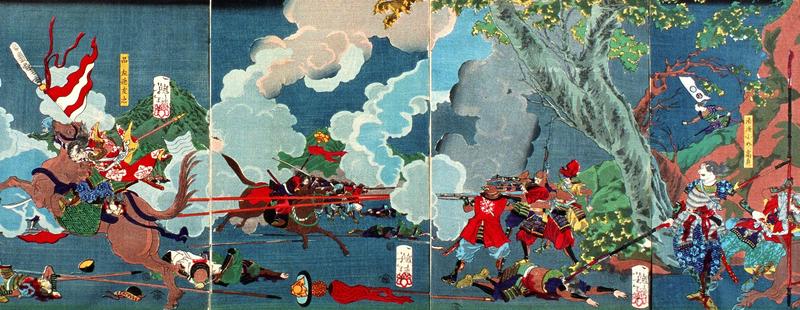Who Shall Be Shōgun?
By | November 22, 2019

Japan since its earliest recorded histories had been ruled by an emperor. However, starting in the late 12th century their powers were stripped with true ruling authority falling into the hands of a military dictator called a Shōgun. This is short for Sei-i Taishōgun meaning “General of the Expeditionary Force Against the Barbarians.” The Shogunate changed hands among various clans from the 12th century until 1467 when Japan entered a period of civil war known as the Sengoku or “Warring States” period.
The ruling Ashikaga Shogunate rapidly lost power as local lords, called daimyōs, each strove against each other in a ceaseless civil war. It took three legendary characters in Japanese history to unite the country and restore peace: Oda Nobunaga, Toyotomi Hideyoshi, and Tokugawa Ieyasu. But only one of these three would attain the ultimate prize and become Shōgun.

The first unifier, Oda Nobunaga, was born in 1534 the son of a fairly obscure daimyō near Nagoya. A successful warlord, Nobunaga came to dominate the Ashikaga shogun, turning him essentially into a figurehead. He used military force with divide and conquer tactics to subdue his enemies. He massacred thousands in his quest for power. A popular epigram attributed to Nobunaga sums up his personality. In answer to how the warlord would get a caged bird to sing. Nobunaga’s responded, “If the bird doesn’t sing, kill it.”

By 1582, Nobunaga had managed to unite half of Japan under him. However, that same year he was assassinated by one of his own generals, Akechi Mitsuhide for indeterminate reasons. Four vassals attempted to set up a regency for the slain warlord’s infant grandson, but this failed.

The second unifier was one of Oda’s generals, Toyotomi Hideyoshi. He seized power after Nobunaga’s death Born in 1536, Hideyoshi was born a peasant but because of his ability and the fractiousness of Japan during the Sengoku period, he was able to cross class lines. Hideyoshi’s answer to how to get the bird to sing was, “If the bird doesn’t sing, make it.” In huge campaigns, he subdued northern Honshu, Shikoku, and Kyushu. He did not become Shōgun, probably due to his status as a commoner, but took the title kampaku, meaning imperial regent. This title was hereditary to the ancient Fujiwara clan, but the clan chose to adopt Hideyoshi in order to maintain tradition.

Hideyoshi did much to restore imperial dignity. He financed massive building programs of ostentatious palaces and temples that flaunted state power. The kampaku ruled through the traditional feudal vassal system which allowed the fractious daimyō s to retain some of their own autonomy leading perhaps to a quicker reunification of the country. In 1588, he disarmed all but the warrior samurai class and fossilized class positions so that none could rise above their station as he had done himself.

As Hideyoshi grew older, a certain strain of megalomania set in. After the birth of his son Hideyori in 1593, Hideyoshi killed his nephew and others who might be a threat to his son’s ascension. Hideyoshi had ambitions of a much larger Asian empire and dreamed of conquest. He launched an invasion of Korea that ended in abject failure. This weakened his prestige.
In 1597, Hideyoshi died after a short illness. With his heir Hideyori still a child, a five-person regency was established to rule Japan. Predictably, civil war followed and another of Nobunaga’s generals, Tokugawa Ieyasu rose to dominance.

Tokugawa Ieyasu was born in 1542 to a minor daimyō in Okazaki. As a boy, he spent time as a hostage of a rival clan. It may be during this period that Ieyasu may have developed the patience that was his hallmark. As a young daimyō , he managed to make an alliance with Nobunaga. After the assassination of Nobunaga, he almost went to war with Hideyoshi but decided to patiently wait. He became Hideyoshi’s vassal. Together they conquered the powerful Hōjō clan. In return for the service, Ieyasu obtained fertile fiefs from the Hōjō in the east of Japan, the Kanto Plain. Unlike other vassals of Hideyoshi, Ieyasu avoided becoming involved in the war in Korea. As a result, he was able to strengthen his own position so that by the time of Hideyoshi’s death, his power was secure.
To get the bird to sing, Ieyasu said, “If the bird doesn’t sing, I’ll wait for it to sing.”

The death of Hideyoshi and the subsequent squabbling of the regents ended with two factions being formed. Those that were loyal to Hideyori and those that followed Ieyasu. In 1600, the two factions met at the Battle of Sekigahara in which Ieyasu won a decisive victory. He became Shōgun in 1603. He retired in 1605 handing over the title of Shōgun to his son. Even retired, Tokugawa Ieyasu ruled Japan until his death in 1616.

The Tokugawa Shogunate reigned over Japan until the 19th century. The Tokugawas led Japan through its Edo Period, so named after the capital of Edo (today’s Tokyo). During this time, Japan entered a period of isolation which would only end after the arrival of the American Navy under Commodore Matthew Perry in 1853. Tokugawa Ieyasu died in 1616 but the political structure he established led to two centuries of peace and set the stage for the emergence of modern Japan in the nineteenth century.

